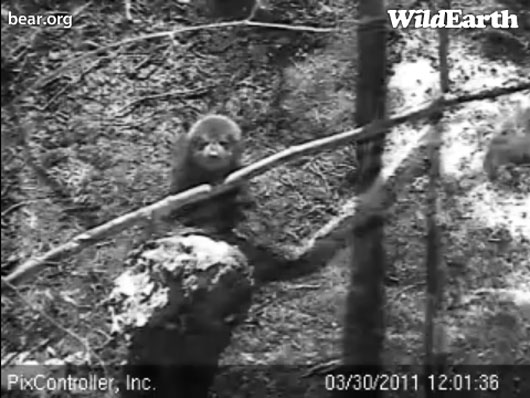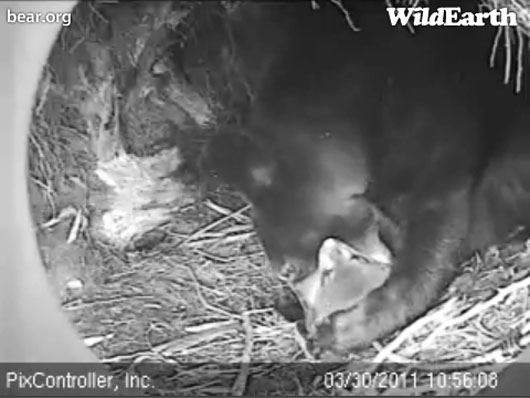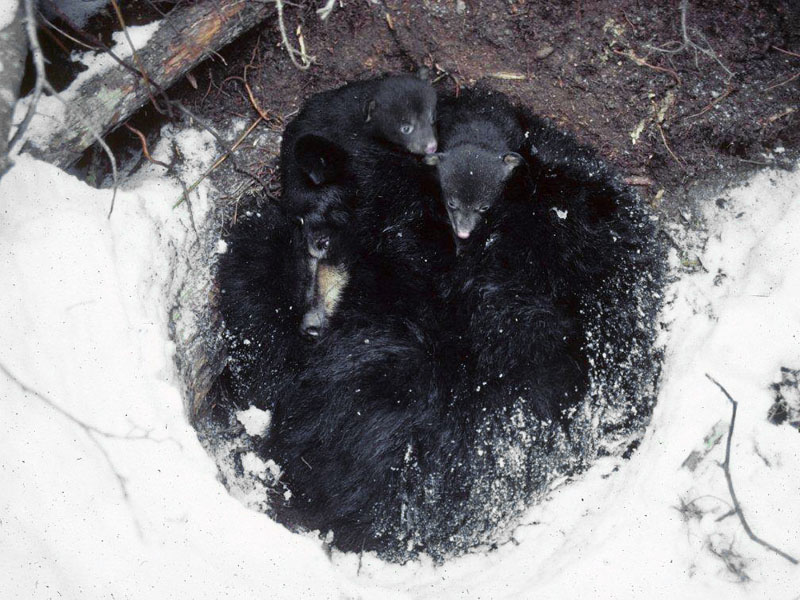Our Den Days are Numbered
 Lily exited the den this morning leaving Hope in charge. Hope played with the cubs and wore them out before joining Lily outside. The exhausted cubs curled up together and slept soundly in the den while Lily and Hope explored outside. The cubs eventually came out and did some exploring of their own. They’re getting around better and better each day. They now can walk faster than the PTZ camera can pan! Jason practiced his tree-climbing skills and even tried walking on the slippery den cam tube. Tried is the operative word – he slipped off the tube just like cubs slip on smooth-barked trees. Fortunately it was a short fall.
Lily exited the den this morning leaving Hope in charge. Hope played with the cubs and wore them out before joining Lily outside. The exhausted cubs curled up together and slept soundly in the den while Lily and Hope explored outside. The cubs eventually came out and did some exploring of their own. They’re getting around better and better each day. They now can walk faster than the PTZ camera can pan! Jason practiced his tree-climbing skills and even tried walking on the slippery den cam tube. Tried is the operative word – he slipped off the tube just like cubs slip on smooth-barked trees. Fortunately it was a short fall.
 In the spring of 2007, Lily fell from a smooth-barked aspen when she was a cub. It was late April and her mother June had climbed a large aspen to feed on catkins. All 3 cubs scrambled up after her—Lily in the lead as usual. About 20 feet up, the rough older bark gave way to smooth younger bark and Lily plummeted to the ground. She shook herself, hesitated, then started back up the tree.
In the spring of 2007, Lily fell from a smooth-barked aspen when she was a cub. It was late April and her mother June had climbed a large aspen to feed on catkins. All 3 cubs scrambled up after her—Lily in the lead as usual. About 20 feet up, the rough older bark gave way to smooth younger bark and Lily plummeted to the ground. She shook herself, hesitated, then started back up the tree.
 With the cubs outside the den and Lily often busy playing with Hope, a person’s mind goes to predators like wolves. How much danger are they? Surprisingly little. In checking 206 occupied dens back in the 1970’s, only two had wolf tracks at their entrances. One was a 5-year-old female that had been gut-shot and was within 2 weeks of dying from the bullet. A pack of wolves visited her den on November 10, 1970, but she was in a secure burrow under the roots of a tree, and the wolves did not make contact. The other was a 16-year-old that had an exposed surface nest with ready access to her from two sides. She and her newborn cubs were killed by a pack of nine wolves in mid-February 1977.
With the cubs outside the den and Lily often busy playing with Hope, a person’s mind goes to predators like wolves. How much danger are they? Surprisingly little. In checking 206 occupied dens back in the 1970’s, only two had wolf tracks at their entrances. One was a 5-year-old female that had been gut-shot and was within 2 weeks of dying from the bullet. A pack of wolves visited her den on November 10, 1970, but she was in a secure burrow under the roots of a tree, and the wolves did not make contact. The other was a 16-year-old that had an exposed surface nest with ready access to her from two sides. She and her newborn cubs were killed by a pack of nine wolves in mid-February 1977.
Surprisingly, many of the dens were surface nests with little protection. And mothers in these dens had noisy cubs that sound like animals in distress. That’s the kind of sound hunters make with predator calls. However, the only visit to such a den was the visit to the 16-year-old that was killed. It’s possible that tracks at other dens were covered by snow by the time we visited in March or early April. But Lily is contributing data to that question. With around-the-clock monitoring of any disturbance, the only disturbances we’ve seen were the moose the other day and the barking dog last year. No wolves.
 Still, it’s confusing. We think the reason mothers stay at dens until the cubs can climb to safety is predators. On the other hand, some pregnant females den in exposed locations that provide little protection. The picture shows a mother with cubs in a very exposed ‘den’ back in March 1980.
Still, it’s confusing. We think the reason mothers stay at dens until the cubs can climb to safety is predators. On the other hand, some pregnant females den in exposed locations that provide little protection. The picture shows a mother with cubs in a very exposed ‘den’ back in March 1980.
Today, we heard Judy Herzog give an excellent interview and pitch for protection for radio-collared bears on KDAL radio. She was cool, thoughtful, gracious, and very well spoken in the face of a totally unsympathetic host with a derisive tone. We were proud of Judy who was speaking all the way from Germany. The host was uninformed on the subject and tried to put Judy on the spot. After the interview, the host played to the power, the DNR, by making a statement that sounded like he had not listened to Judy’s points at all. In his mind, the DNR was right no matter what. The commissioner was coming on the show in the next hour. Way to go, Judy. You were great!
Helen Schwarz found a way to make a cute informative slide show online with her Kindergarten students at http://secure.smilebox.com/ecom/openTheBox?sendevent=4d6a4d344d4445354d6a5a384e544d354d544d774e44553d0d0a&sb=1.
In the Readers Digest contest, we are gaining on the 5th and 4th place cities to give us some security for staying in the top six (the money spots) in case a fast-moving city moves up. The site for casting 10 votes (all at once) a day is http://wehearyouamerica.readersdigest.com/town.jsp?town=ELY&state=MN.
Please check for recent ‘bearstudy’ video uploads on YouTube at http://www.youtube.com/user/bearstudy#g/u.
Thank you for all you do.
—Lynn Rogers and Sue Mansfield, Biologists, Wildlife Research Institute and North American Bear Center
